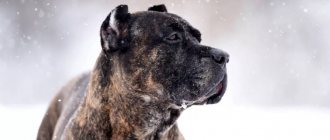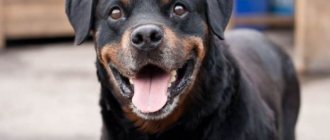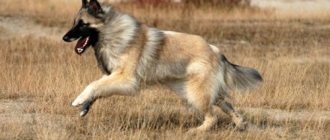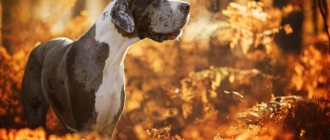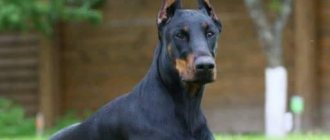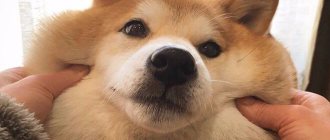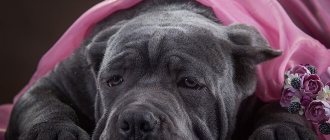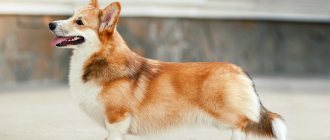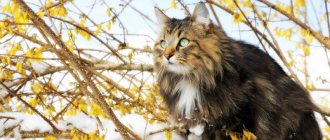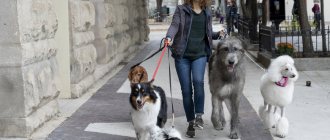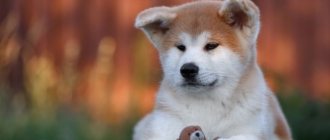Breeds
Have you heard anything about Chinooks? Hardly. This is a rare breed of Chinook dog. To those who see them for the first time, it seems that the same dog lives in the neighboring yard or runs along the street of his hometown. In fact, to form this breed, enthusiasts made considerable efforts. They crossed males and females of different breeds with each other, achieving the same type of livestock so that the breed was recognizable.
Chinooks have a certain character, they are hardy, strong and bred by people specifically to pull sleds with people and loads in a harness.
Dogs can work in extreme cold. At that time, there was a need for such powerful working dogs capable of carrying large loads. A good pace was also required from the team so that the cargo was delivered to the customer in the shortest possible time.
History of appearance
The Chinook dog breed was introduced in the last century to the United States by Arthur Walden. His goal was to create a sled dog with the same speed as a Husky, but with a stronger build.
As the basis for the Chinook, Walden used a St. Bernard, an Eskimo Spitz, a mongrel and a Great Dane. As a result, the result is a Chinook, which has no competitors in the role of a sled dog, can drag heavy loads, and is an excellent protector.
The breed acquired its name thanks to the Chinook sled dog, which was distinguished by its tirelessness.
Price
It is best to purchase a baby from a nursery. If you take it from a private owner, he may suffer from some hereditary diseases.
Like other pets, Chinooks can get sick. Most often it will be: allergies with skin diseases, eye diseases with dysplasia, cryptorchidism, convulsions are possible. Therefore, it is best to buy a puppy from a nursery or from an experienced breeder who will show the hospital record of his father and mother.
Since there are few dogs, buying a puppy is difficult, but possible. It costs 25 thousand rubles. average.
Number
Now the breed is recognized as the rarest in the whole world, but even when its representatives were at the peak of their popularity, their number was no more than three hundred individuals.
And in 1966 it fell to 125, in 1978 – to 28.
When the number of representatives of the breed decreased so much, its rapid reproduction began, as a result, now there are no more than 500 individuals left in the whole world.
Health and characteristic diseases
Although the Chinook is large and formidable at first glance, it also has health problems. Most often this breed suffers from:
- allergies. It manifests itself as skin rashes and redness of the eyes;
- hip dysplasia. Animal bones do not always withstand an active lifestyle;
- epilepsy;
- cryptorchidism.
The Chinook is a truly unique breed, created by combining the best properties of other species. This dog was an excellent helper for humans in the harsh conditions of the frosty North, and it will not let you down in everyday life. Finding a puppy of this breed is really difficult, but it is quite possible. The main thing is, before getting such a pet, evaluate whether you are capable of being a true friend to it.
Role for the US
Thanks to the clubs that began to protect these dogs, they still exist. But this breed was not recognized by any cynological organization due to their small numbers.
In 2009, representatives of the breed became the new symbol of the state of New Hampshire in the USA.
Character of a sled dog
Chinook is a great friend, because it is characterized by:
- devotion, fidelity. These dogs are famous for their special sensitivity and love towards their owner, so in the person of a Chinook a person will gain a friend for life;
Did you know? Dogs are capable of love similar to humans. When they come into contact with people they like or other four-legged animals, their brain releases oxytocin, the love hormone. The same one is produced in humans during hugs and kisses.
- high level of intelligence. The breed was created to work in the difficult conditions of the North; for this, the animal needs to be able to navigate, analyze the situation and make the right decisions along the way. In snowstorms and impenetrable darkness, man was powerless, and only sled dogs ensured his survival;
- calmness. The influence of northern latitudes is also felt in the cold, reasonable temperament of the Chinook. Aggression is alien to him, he shows it only as a defense, and can also get nervous when the situation changes;
- kindness and friendliness. This wonderful dog will find a common language with both children and pets, including other dogs. He does not tolerate loneliness well, he may even get sick because of it;
- silence. The Chinook is not a good watchman; this breed rarely barks. But one should not consider him a coward. Such a dog is able to fight back any threat that hangs over him or his owner. Bravery, coupled with considerable size, most often ensures victory for the Chinook over the enemy;
- activity and performance. This dog was originally supposed to race through the snow for hours with a load on its back. And although today the need for this has disappeared, the energy reserve remains.
Important! Such energy is both an advantage and a disadvantage, because not every owner has enough time and energy for long walks and training. And without them the animal does not feel well. The disadvantage of the breed is called late maturation: often an adult dog at the age of 2 years fools around and chases cats like a puppy.
Personality
They love to learn, they love to be at one with a person and do one thing, they are very hardy and generally love work, no matter what it is. They treat strangers with caution, but without aggression. These dogs love children very much and can be excellent nannies, although if the child is very small, you need to take into account that with one careless movement the Chinook, simply because of its size, can knock the child down.
This breed strives to please the owner, but without stupid groveling, rather, they like to feel like they are part of a team. Therefore, there are no problems in training with them - they are very versatile. If you, for example, need a guard dog, you can quite achieve this. Like other dogs, they should not be chained, as this will have an extremely negative impact on their psyche.
Appearance
Puppies and adults of the Chinook dog breed are incredibly beautiful, the coat is almost golden in color, there are dark spots on the muzzle, ears and tail, from the cheeks to the inside of the legs, there are white inclusions. The muzzle is long, strong jaw, dark eyes. Their height at the withers is 60-70 cm, weight is about 35-45 kg.
These dogs have an athletic build and are very strong and flexible. They have an excellent sense of smell and hearing.
It is thanks to these characteristics and great strength that they were used as sled dogs in the Antarctic Expedition. They could drag 60-65 kg of cargo each.
The peculiarity of this breed is that its representatives mature slowly. So, at the age of two, they will still be playing and frolicking, perhaps chasing squirrels and cats.
In addition, at the age of 2 years, these dogs do not even look like adults in appearance, you can verify this by looking at a photo of a Chinook dog.
Features of training
Chinook breeders note the ease of training dogs of this breed: they quickly remember commands and are not stubborn in the process. The puppy must be socialized, but given the sociability and friendliness of the Chinook, this will not be difficult.
The dog must undergo a general team training course, as well as training to confirm the owner’s leadership. In any case, the Chinook will try to please its owner, but it is necessary to properly build a relationship with him. Training begins no earlier than six months of age, when the puppy is a little stronger.
Care
The breed is very clean and often licks itself, which eliminates the need for frequent bathing.
The owner only needs to regularly remove the fur from the animal. A stiff brush can be great for this. You cannot do without this tool, since during molting the animal loses a lot of hair.
You should refrain from winter swimming, since the animal has a weak immune system.
Content Rules
For a dog like a Chinook, the conditions of an apartment are completely unsuitable, but a private house with a spacious enclosure and a yard is just right. It is better for an animal to sleep in a dry and comfortable room. Since the dog needs communication with its owners, you need to give it the opportunity to go inside the house. Dogs of this breed are very clean; they tidy their fur themselves. The only thing you need is to comb out the pieces of fur with a brush. It is enough to do this once a week, and during the molting period - three times a week.
Dogs need to be bathed infrequently, since they are very careful: twice a year is enough. After bathing the dog, you need to dry it well with a towel or hairdryer, since the thick undercoat takes a long time to dry. In the cold season, it is better to avoid water treatments to avoid colds. Ears, eyes, teeth and claws also need cleaning.
- Ears need to be cleaned infrequently , since the wax layer creates a protective layer against dust and moisture entering the ear canals. To determine when to carry out the procedure, you need to lightly rub a cotton swab in the ear canal, and if pieces of wax appear on it, it’s time for cleaning. Cotton pads are used for this; they remove dirt well and cannot damage the channels. Sanitary napkins also work well. They contain a special product that has dissolving properties and gently cleanses, and does not cause irritation.
There are also ear cleaning lotions on sale; they are very easy to use: place a few drops of the product in the ear, after 2-3 minutes the dirt will dissolve and come out when the dog moves.
- The dog's eyes are cleaned if necessary. Sometimes liquid accumulates in the corners, which needs to be removed with a cotton swab or gauze soaked in saline solution. For more serious problems (severe watery eyes, red eyes, or foreign objects), you should take your pet to a doctor.
- The Chinook's teeth, like any predator's, need care. The yellow plaque that appears on them can lead to tooth loss or diseases of other organs of the dog. To prevent this, it is necessary to accustom the animal to brushing its teeth from puppyhood. For small dogs, you can use a device that fits on your finger, and for large dogs, a regular toothbrush. You need to buy a specialized paste from a veterinary pharmacy.
Acquisition
If you are interested in the question of where to buy a Chinook dog, then you should understand that this can only be done in specialized Russian nurseries that directly cooperate with American nurseries.
The price of a Chinook dog is about $1,000, but to purchase it it is not enough to have money; the owners of the kennel must make sure that the future owner will be able to properly look after the animal.
If you are fabulously lucky and still managed to buy this puppy, you are recommended to study his pedigree. These dogs often suffer from genetic diseases.
How to choose a Chinook puppy
Finding a Chinook puppy is very difficult. It's not even about the cost, which starts at $1,000, but about the rarity of the breed. Most likely, it will have to be transported from abroad, and only in case of great luck, if the breeder wants to part with his valuable and rare specimen in your favor.
I looked through several advertisements for the sale of dogs (or rather, there were no advertisements themselves, only an offer to leave a request for a specific breed). In principle, from this we can conclude that we do not have nurseries for breeding Chinooks in Russia. But many people brag about their pets, suspecting them to be Chinooks. But this simply cannot happen, although yard dogs may well resemble this breed in appearance. And if you want to believe that there is a Chinook next to you, please believe it. But the authenticity of the breed can only be confirmed by pedigree. Does your pet have it?
When choosing a puppy, you are unlikely to be able to determine its breed by appearance. Focus solely on the pedigree and do not listen to any heart-warming stories about a runaway or randomly picked up pet. Such cases are from the realm of fantasy. A mongrel will be no worse friend to you than a Chinook, but it’s hardly worth giving a tidy sum to scammers for it.
Belonging to the breed is best confirmed by the Chinook pedigree
If you are lucky enough to find a real Chinook, carefully read its main document - this breed has a high risk of genetic pathologies.
Rotorcraft warfare
Among the first American military units to arrive in 1961 to assist the South Vietnamese ally were two US Army Air Corps transport companies equipped with H-21 flying bananas. In 1962, three more companies arrived in Vietnam. Along with the army aviation companies, divisions of the US Marine Corps also headed here. Unlike army companies, Marine divisions were equipped with S-58 helicopters. In hot climates and high mountain conditions, they turned out to be much more effective than the N-21. In 1963, the bulky “flying bananas” began to be replaced by the latest light multi-purpose helicopters, the Bell 204 and then the Bell 205 Hugh. Very well designed, equipped with a powerful gas turbine unit, the reliable and durable Bell Hugh became the main rotary-wing fighter of the war and a kind of symbol of Vietnam. annually sent hundreds of such machines to Indochina, bringing their production to a record 1,650 units in 1967. Modifications of "Hugh" are still produced. The total number of aircraft built reached 16 thousand, an absolute world record in helicopter manufacturing.
Performance characteristics of the CH-47 and similar helicopters
The table shows the basic data of the Chinook, comparing it with the closest domestic and foreign analogues. Low-volume and experimental helicopters are not taken into account.
| Parameter | CH-47 E | CH-53 D | Mi-6 | SA.321 SuperFrelon |
| Fuselage length, mm | 1554 | 20470 | 33160 | 19400 |
| Height, mm | 5770 | 5220 | 9160 | 6660 |
| Main screw diameter, mm | 18590 | 22020 | 35000 | 18900 |
| Cargo compartment length, mm | 9200 | 9140 | 12000 | 7000 |
| Cargo compartment width, mm | 2290 | 1980 | 2500 | 1830 |
| Cargo compartment height, mm | 1980 | 2290 | 2650 | 1900 |
| Maximum speed, km/h | 298 | 307 | 340 | 249 |
| Cargo weight in the cabin, kg | 8164 | 13608 | 12000 | 6700 |
| Weight of suspended cargo, kg | 10341 | 9072 | 8000 | 5000 |
| Flight range, km | 2026 | 1641 | 1450 | 1020 |
| Ceiling, m | 3215 | 2195 | 2250 | 2170 |
| Passenger capacity | up to 55 | up to 55 | up to 90 | up to 37 |
| Armament | 3 x 7.62mm machine guns | 2 x 12.7mm machine guns | 1 x 12.7mm machine gun | 1 x 20mm gun |
The main competitor of the Chinook was its compatriot - the Sikorsky CH-53 helicopter. When the Marine Corps felt the need for heavy helicopters, it was the CH-53 that emerged as the winner of the announced competition. And the fleet used these helicopters as anti-submarine helicopters.
CH-53 helicopter
The French SuperFrelon (Super Hornet) helicopter, not inferior to the CH-47, turned out to be in little demand and was used primarily by the fleets of several countries, although China even established its licensed production. The choice of the Hornet by the South African armed forces is generally explained simply. France was not a member of NATO, and therefore could sell military equipment to South Africans.
The only representative, the Yak-28, set two world records; during its entire service life, not a single disaster occurred with its participation. But the “circulation” of forty pieces (according to other sources - fifty) is a crumb compared to more than a thousand CH-47.
But the heavy single-rotor Mi-6 became widespread. It had impressive characteristics, set 16 world records, but was inferior to the CH-47 in durability and was not so widely distributed. And in combat, the “Hook” (NATO designation for the Mi-6) was used to a limited extent.
Helicopter MI-6
This in itself does not mean anything, but against the backdrop of the Chinook’s impressive achievements, it does not look like an advantage. The descendant of the “Hook”, the giant Mi-26, surpassed the CH-47 in capacity and payload capacity to such an extent that it can even be considered a representative of a different class.
General description of the breed
You are probably already interested in the breed itself. So, let us present to you a general description of Chinook dogs.
Dimensions. The dog has fairly well-developed muscles and a fairly athletic build. And this is not in vain, because dogs were invented to work. In height, this breed can reach up to 65 cm, and weight ranges from 25 to 40 kg.
Wool. The coat color is mainly yellow with hints of gold. Also, the coat can be honey-colored, and individuals with dark coat are very rare.
Fluffiness. This breed is not particularly fluffy.
Note!
Nicknames for dogs for boys - easy, rare and most beautiful names for dogs in alphabetical order
Nicknames for girls' dogs - a list of beautiful, funny, unusual nicknames for large and small dog breeds
Maltipoo dog - everything about the dog from A to Z. Photos, description of the breed, character, maintenance features, prices, reviews
Nicknames
For such a handsome red-haired guy, a sonorous nickname , especially since they are most often used for carts or in service. So the dog must hear his name the first time, which means that it must be clearly pronounced and be easy for the dog to understand.
- For boys: Agate, Bim, Black, West, Wolf, Dick, Jack, Kent, Losk, Nest, Knox, Oscar, Pirate, Red, Skif, Tom.
- For girls: Aza, Alice, Belka, Becky, Dina, Zhuzha, Lada, Lizi, Naya, Nora, Palma, Tina, Elsa.
Diet
Meat is the basis of the Chinook diet.
Dry food is most often used to feed dogs. It is recommended to choose products from well-known manufacturers that have already proven themselves in the market.
People who do not want to feed their pet food can independently create a daily diet for it. It should include the following products:
- lean meat;
- cereals (rice, buckwheat);
- non-starchy vegetables;
- fruits;
- fermented milk products.
You need to feed the dog twice a day. However, each portion should not be too large. 300-400 grams is enough.
Miniature Bull Terrier
A miniature bull terrier (minibull) is a smaller copy of a standard bull terrier (both are fighting dog breeds). Today they are very rare dogs, but there are prospects for a further increase in the number. The minibull was bred by selecting dwarf puppies that appeared in standard litters as a result of a mutation. In most regions, the Miniature Bull Terrier is bred as an independent breed, but in some countries (Australia, New Zealand) new crossings with the standard variety are allowed to improve its gene pool.
The Miniature Bull Terrier is a rare combination of a small body with an iron will, stubbornness, determination and physical strength. A properly raised and socialized minibull is affectionate and devoted to its family; in ordinary life it is not aggressive, but at the slightest provocation it is ready to attack offenders. A distinctive feature is the egg-shaped head, the muzzle in profile has the outline of a smoothly curved arc. The rarest breed of Minibull dog is suitable only for experienced, physically strong owners. Used as a security guard, bodyguard, companion. Height – up to 35.5 cm.
The article does not list all the rarest dog breeds; in fact, there are many more of them. They are bred by real enthusiasts, whose names remain forever inscribed in the history of cynology.
I like1I don't like
Which owner is it suitable for?
The first requirement for a future Chinook owner is to have time for the pet. Every dog needs attention, but such a dog will become another member of the family. Moreover, an active member. He will need training, regular training, long runs in the fresh air, fun games to use up his huge energy reserves. And the owner should be prepared for this.
Chinook is a pack breed. Such a dog must have a leader, otherwise the dog will decide that he is the leader. In this case, you will not envy the owner. To control such a beast, you need to have a strong character and will. These traits will be especially useful during the learning process.
Modifications
YHC-1B Chinook under development
Military modifications
- CH-47A
: basic version. - ACH-47A
(Armored CH-47A): "F gunship", variant with enhanced armor and weapons. - CH-47V
: modification with new engines and blades. - CH-47S
: modification with new engines. - CH-47D
: modification to increase service life, payload and other characteristics. Since 1993, a program has been launched to extend the service life of existing CH-47Ds by an additional six years. - CH-47D International Chinook (Model 414—100)
: first export modification of the CH-47D - NS.Mk.1
and
Mk.1V
: CH-47 variant for the British Air Force - MH-47D
: Special operations variant with in-flight refueling capability, roller launch system and other upgrades. Six MH-47D helicopters were converted from CH-47A, six from CH-47C. - S/MN-47E
: multi-role version with increased range and in-flight refueling, weapons and new equipment. - CH-47F
: Development of the CH-47D with new engines, avionics and airframe. - MH-47G
: Special operations variant based on the MH-47E with new avionics. - HH-47
: rescue modification of the MH-47G. - CH-47J
: variant for the Japanese Self-Defense Forces. - CH-47SD (Super D)
: further modernization of the CH-47D, larger fuel tanks, improved digital controls
Civil modifications
- Model 234LR (Long Range)
- Model 234ER (Extended Range)
- Model MLR (Multipurpose Long Range)
- Model 234UT (Utility Transport)
- Model 414
Other significant incidents
- On September 11, 1982, an American CH-47C (serial number 74-22292) carrying paratroopers crashed at an air show in Mannheim (Germany). 46 people died. The cause was blockage of lubrication of the transmission bearings due to the accumulation of crushed walnut shells used to clean the mechanisms.
- On November 6, 1986, the British Chinook of British International Helicopters, returning from the Brent field platform in the North Sea, crashed into the sea four kilometers east of Sumborough Airport after an explosion. 45 people died, two were rescued by a coast guard helicopter.
- On March 30, 1987, a Libyan Air Force CH-47C was hijacked to Egypt.
- In 1988, a US Army CH-47 participated in the evacuation of a Mi-24 helicopter abandoned by the Libyan army in the desert during the war in Chad. With a helicopter on an external sling, the Chinook covered a distance of 900 km at night in a sandstorm with one in-flight refueling.
- On June 2, 1994, for an unknown reason, a Royal Air Force Chinook crashed into the slope of the Mull of Kintyre headland. All 4 crew members and 25 passengers, MI5 employees, were killed.
- On May 29, 2001, the Chinook of the South Korean army, while installing a sculpture on the Olympic Bridge in Seoul, hit it with its main rotor. The fuselage broke, one part fell into the river, the second onto the bridge and caught fire. All three crew members were killed.
- On September 11, 2004, a Chinook belonging to the Greek army crashed in the northern Aegean Sea. 17 people died.
- On August 6, 2011, a NATO Chinook CH-47 helicopter was shot down by a missile in the Wardak province of Afghanistan, west of Kabul. All 38 people on board were killed. The helicopter was carrying American and Afghan troops: 22 SEALs from the Naval Special Warfare Group (NSWDG; SEAL Detachment 6), 5 members of the 160th Special Warfare Wing, 3 members of the US Air Force Combat Control Unit, military dog handler, civilian translator, 7 soldiers and a service dog.
Helicopter overview
Since that time, more than one variant has been produced, including the CH-47B, which has T55-L-7C turboshaft engines with a shaft power of two thousand one hundred and twenty-five kilowatts (two thousand eight hundred and fifty liters per second), with a new design of blades on the main rotor. The first model took to the air in October 1966, and delivery began on May 10, 1967. It was followed by the CH-47C model, which had two T55-L-11C turboshaft engines and a power of two thousand seven hundred and ninety-six kilowatts (3,750 hp), a reinforced transmission and a larger fuel tank capacity. The first model of such a helicopter flew on October 14, 1967, and at the beginning of 1968, production vehicles began to be delivered.
Nine vehicles similar to the CH-47C model were built for the Canadian Armed Forces, designated CH-147. Deliveries began in September 1974. This model was equipped with the latest safety and flight control systems, the optimal weight during take-off from the ground was 22,268 kilograms, and during an emergency take-off from water - 20,865 kilograms. In addition, five shooters could sit in the cockpit; each one had at his disposal a machine gun with a caliber of 12.7 or 7.62 millimeters, placed on a flexible guide. In accordance with the development program of the American Army, one helicopter of each model - CH-47A, CH-47B, and CH-47C was dismantled to the main frame with further reconstruction to obtain an improved standard, which became the prototype CH-47D.
These improved helicopters had more powerful turboshaft engines, a transmission with an increased gear ratio and new electronic equipment, and their design was subjected to many changes. They use an auxiliary power unit and a triple hook system to hang the load. After the flight tests of these prototypes were completed, the American company Boeing Vertol began to carry out programs to convert CH-47A helicopters to the CH-47D standard, and the first of them was delivered in 1982. The British Home Force has placed an order for 33 helicopters similar to Canada's CH-147 variant, designated Chinook HC.Mk I. They have British equipment and several specially designed attachments. The first device was delivered in August 1980, and at the beginning of 1982 all thirty-three machines were delivered. Since 1970, Chinook helicopters began to be produced in Italy for customers.
Helicopter video
https://youtube.com/watch?v=qWU5eOHfSqE
Author of the article: Nikiforov Vladislav
Investigations
Initial
Kamaz showed the first official photo of a gigantic 10x6 dump truck
By 1995, the Royal Air Force Commission investigating the causes of the disaster concluded that it could not name the exact cause of the disaster due to the lack of convincing evidence. Initially, a version of a terrorist attack was considered, namely that the helicopter was shot down from the Strela-2 MANPADS of the Irish rebels, but it was quickly ruled out, since no debris was found that was located at a significant distance from the crash site. Two senior RAF officials reviewed the evidence and concluded that the culprits were pilots who were grossly negligent by flying too fast and at too low an altitude in thick fog. The investigation and its results were criticized by many because it was not clear what caused the disaster: crew errors or technical malfunction. In 2011, a British Parliament report found that those who led the investigation found no conclusive evidence of pilot negligence.
Further
After the first scandalous investigation, further checks were carried out. The results of the 1996 crash investigation, the House of Commons Defense Committee report in 2000 and the House of Commons Public Affairs Committee report at least left the question of pilot guilt open. The pilots' families and leading politicians (including former Prime Minister John Major and former Defense Secretary Malcolm Rifkind) called for a re-investigation, which began in 2001 at the initiative of the House of Lords and lasted from September to November. On January 31, 2002, the results of the investigation were published: the pilots were unfoundedly accused of gross negligence.
In December 2007, Defense Secretary Des Broune agreed to draw up a new report on the disaster. On December 8, 2008, Defense Secretary John Hutton said that the report did not present new evidence and that the verdict against the pilots remained in force. On 4 January 2010, the investigation resumed following the release of an internal UK Ministry of Defense document published 9 months before the disaster. The document said the engine software was "definitely dangerous" because it could cause both engines to fail. In 2011, a report was published citing unfounded criticism of the investigation commission, which accused the crew of not paying enough attention to the technical characteristics of the helicopter.
On 13 July 2011, Defense Secretary Liam Fox told members of the House of Commons the findings of an independent investigation carried out in 1994, which cleared the pilots of any gross negligence charges.
The Government noted Lord Alexander Philip's confirmation that the Chief Air Officer's statement, published in 1993, was approved by the RAF. According to this statement, the aviation crew did not have the right to use the navigation systems and communications equipment of Chinook HC2 type helicopters, therefore such helicopters did not have permission to fly
However, this statement was hidden from the pilots, and so the RAF erroneously concluded that the helicopters met all safety requirements. In December 2012, Secretary of State for the Armed Forces Andrew Robathan confirmed that making a false statement was not an offence, even though it directly resulted in the death of military personnel.
Combat use
Downed American CH-47 during the Vietnam War
American CH-47s in Afghanistan. 2008
USA
During the Vietnam War he proved himself to be the best. In addition to transport purposes, it was used as a smoke screen producer, an aerosol sprayer, and a tow truck for damaged and abandoned aircraft. 4 units of “flying artillery” ACH-47A also passed military tests
In total, the United States used 550 CH-47A helicopters, carried out 2.6 million helicopter sorties with 1,182 thousand flight hours, of which 996 thousand hours were in combat conditions, transported about 8.5 million people and 4.5 million tons of cargo, More than a thousand aircraft worth a total of ~3 billion dollars were evacuated. Also, during the evacuation of Vietnamese refugees, a unique record was recorded in the transportation of manpower: 147 people with belongings.
70 such helicopters since 1972. received by South Vietnam.
During the entire Vietnam War, the United States alone, according to various sources, lost from 170 to 200 CH-47s (of which 136 were from the US Army). The losses of the Chinooks of South Vietnam are unknown. The North Vietnamese captured 36 Chinooks as trophies.
Varieties
This breed has three varieties, which you can get acquainted with later in the article.
Scandinavian (English)
They are distinguished by the presence of a large head, a high tail, a wide chest and an elongated lumbar region. Most often, such dogs can be found in Scandinavian countries, Ireland, Great Britain, and the Russian Federation.
European
This type is characterized by a voluminous head, a well-defined thoracic region, elongated limbs, and a short torso. These Shih Tzus are common in Canada, Australia and almost all of Europe.
American
When compared with the two previous types, such dogs are very often mistaken for a separate breed altogether, due to the presence of the following features: small head, shortened muzzle, flat chest, short body and tail, rather long limbs. The animal is characterized by excessive mobility. You can meet such representatives in both Americas, in the southeastern regions of Asia, in Russia and Belarus.
Ammunition
A pump-action shotgun can fire both shotshells and slugs. The most common is 12 gauge, much less 10, 16, 20 and 36 (.410) gauges. Our arms industry has so far mastered the 12th (IZH-81, TOZ-94, TOZ-194) and 16th (Bekas) calibers. 12 gauge is available in three sizes on the international market: 12x70 (2 3/4 inches), 12x76 (3 inches) Magnum and 12x89 (3 1/2 inches) Super Magnum. The overall effectiveness of the shot, as well as the recoil perceived by the shooter, increases with increasing these parameters. Each barrel is marked with a stamp containing information about what cartridges are allowed to be used in it. In a barrel with a chamber length of 70 mm, it is impossible to use cartridges with a 76 or 89 mm sleeve. A barrel marked 12×70 and 12×76 allows the use of both types of cartridges, etc.
Operators[ | code]
Military | code
Countries that use the CH-47 Chinook helicopter
- Argentina Argentine Army Aviation - 3 units.
- Argentine Air Force - 3 units. (decommissioned in 2004)
Captured South Vietnamese CH-47 in the Vietnam Museum
- Vietnam
- Greece - 9 CH-47D and 6 CH-47SD, as of 2016
- Netherlands - 11 CH-47D and 6 CH-47F, as of 2016. Additionally, 14 CH-47F were ordered in 2015, the first batch should arrive in 2022.
- Egypt - 16 CH-47D and 3 CH-47C, as of 2016
- India - 5 CH-47F(I) units as of February 2022, 15 units ordered in total
- Iran - 20 CH-47C and more than 2 CH-47, as of 2016
- Spain - 17 CH-47D, as of 2016
- Italy - 13 CH-47C and 13 CH-47F, as of 2016. A total of 16 CH-47F ordered under a 2009 contract.
- Canada - 15 CH-47F, as of 2016
- Libya - 2 CH-47C, as of 2016
- Morocco - 10 CH-47D, as of 2016
- UAE - 22 CH-47F, as of 2016
- Singapore - 10 CH-47SD and 6 CH-47D, as of 2016
- USA - 325 CH-47F, 75 CH-47D and 68 MH-47G, as of 2016
- Thailand - 5 CH-47D, as of 2016
- Taiwan - 8 CH-47SD, as of 2016
- Turkey - 6 CH-47F units ordered in 2011, first deliveries should begin in 2016
- South Korea - 31 CH-47D, 6 MH-47E and 5 HH-47D, as of 2016
- Japan - 27 CH-47D (CH-47J), 30 CH-47JA and 15 CH-47, as of 2016
The meaning of the Russian Navy guy
It was not without reason that Peter the Great, modifying the English-Scottish guis, singled out the cross of St. Andrew the First-Called in first place. According to biblical legends, this apostle was a fisherman, which is why he is considered the patron saint of all seafarers. It is also believed that he preached in the territory of future Rus' and even left two of his pectoral crosses here - in Kyiv and in Volkhov. The image on them was copied in the form of the main element of the Russian guy.
As for the meaning of the colors of the Russian Navy, it is similar to the color symbolism of the main state flag of the country:
- white - purity, purity, peace, perfection;
- red is the color of the blood of the defenders of the Motherland, energy, just cause, strength;
- blue - loyalty, constancy, faith.
